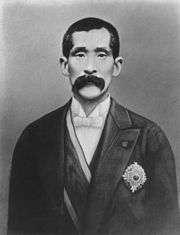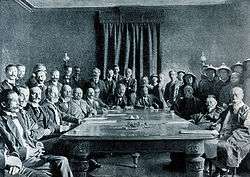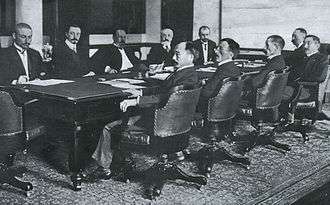Komura Jutarō
| Marquis Komura Jutarō 小村 壽太郎 | |
|---|---|
 Marquis Komura Jutarō | |
| Born |
September 16, 1855 Nichinan, Miyazaki, Japan |
| Died |
November 25, 1911 (aged 56) Hayama, Kanagawa, Japan |
| Nationality | Japanese |
| Occupation | Diplomat, Foreign Minister of Japan |
Marquis Komura Jutarō, GCB, GCMG, GCVO (小村 壽太郎, September 16, 1855 – November 25, 1911) was a statesman and diplomat in Meiji period Japan.[1]
Biography
Komura was born to a lower-ranking samurai family in the service of the Obi Domain in Kyushu's Hyūga Province (present-day Nichinan, Miyazaki Prefecture). He attended the Daigaku Nankō (the predecessor of Tokyo Imperial University). In 1875, he was selected by the Ministry of Education as one of the first students to study abroad under a government scholarship. While at Harvard University, Komura shared lodgings with fellow Japanese student Kaneko Kentarō. In due course, Komura graduated from Harvard Law School in 1878.
Career of government service

In 1880, Komura joined the Ministry of Justice and after serving as a judge of the Supreme Court, in 1884 transferred to the Translation Bureau in the Ministry of Foreign Affairs.

In 1893, Komura was chargé d'affaires at the Japanese legation in Beijing, in Qing dynasty China. In this position, he conveyed to the Chinese government Japan's intention of dispatching troops to Korea under the provisions of the Treaty of Tientsin to subdue the Tonghak Rebellion – actions which led to the First Sino-Japanese War.[2] During the war, Komura was appointed as civilian administrator for territories Japan had captured in Manchuria. He was also a key figure in the negotiations to end the war, culminating in the Treaty of Shimonoseki, which he helped draft.
Following the assassination of Queen Min of Korea, Komura was dispatched to replace Miura Gorō as Japanese minister to Korea.[3] In his position as resident minister in Korea, he negotiated the Komura-Weber Memorandum in May 1896 with his Russian counterpart Karl Ivanovich Weber, allowing joint interference into Korean internal affairs by the Empire of Japan and the Empire of Russia.[4]
Komura served as Vice Minister for Foreign Affairs until September 1898, when he was named ambassador to Washington, D.C..[5]
In September 1901, Komura became Minister for Foreign Affairs under the first Katsura administration, and signed the Boxer Protocol on behalf of Japan. He was elevated into the kazoku peerage with the title of baron (danshaku) in 1902 and decorated with the 1st class of the Order of the Rising Sun. Later in 1902, Komura helped conclude the Anglo-Japanese Alliance in 1902. His tenure as Foreign Minister was marked with increasing tension between Japan and Russia over Korea and Manchuria, cumulating in the Russo-Japanese War of 1904–1905.

After withdrawal of Russian forces in the region, Russian diplomates Witte, Rosen and their Japanese colleagues Takahira, Ochiai, Komura and others met in Portsmouth for signing the peace treaty. During the negotiations, Sergei Witte tried to keep Empire of Russia's rights on southern part of Sakhalin island, referring to Treaty of Saint Petersburg (1875). According to Treaty of Saint Petersburg (1875), Empire of Russia already take Kuril Islands to Japan Empire for rights on Sakhalin, but Komura declared that "war cancels all treaties".[6]
The war was ended with Komura's signature on behalf of the Japanese government of the Treaty of Portsmouth, which was highly unpopular in Japan, leading to the Hibiya incendiary incident[7] Komura also met with E. H. Harriman, the American railway magnate, to propose a joint venture between his conglomerate and Japan towards the development of the South Manchuria Railway. On his return to Japan, he found that the agreement was opposed by the genrō, and was not implemented.
Komura also met with Chinese representatives in Beijing, signing the Peking Treaty of December 1905, which transferred former Russian rights in southern Manchuria to Japan.
For these services, Komura was awarded the Order of the Paulownia Flowers in 1906, and was appointed to become a member of the Privy Council.
From June 1906 to August 1908, Komura served as ambassador to Great Britain, during which time he was made a K.C.B. by King Edward VII and made a member of the Royal Victorian Order. On his return to Tokyo he resumed the post of Foreign Minister in the 2nd Katsura administration, signing the Root–Takahira Agreement with the United States. His peerage title was also elevated to that of Count ("hakushaku") in 1907.
Komura also played a key role in the Japan-Korea Annexation Treaty in 1910, and in concluding various international agreements in 1911 to restore Japan's tariff autonomy. He was elevated to the title of Marquis ("koshaku") on April 21, 1911.
Suffering from tuberculosis in his final years, Komura moved to the seaside resort of Hayama in Kanagawa Prefecture; however, he died of the disease on November 26, 1911. His grave is at Aoyama Cemetery in Tokyo.
In popular culture
Per Ryōtarō Shiba in his semi-historical work Saka no Ue no Kumo, Komura inherited massive debts from his father, which he had difficulty with repayment. As a result, he wore the same frayed frock coat for years, regardless of season or occasion. This, combined with his short statue and large mustache, led to the derisive nickname of "the rat minister" in the diplomatic community in his early career.[8] In the Japanese Taiga drama adaptation of Shiba’s work, the role of Komura is played by actor Naoto Takenaka.[9]
Honors
From the article in the Japanese Wikipedia
Peerages
- Baron - 7 February 1902
- Count - 21 September 1907
- Marquis - 21 April 1911
Decorations and ranks
- Order of the Sacred Treasure, Third Class (31 October 1895)
- Grand Cordon of the Order of the Rising Sun (27 February 1902; Second Class: 21 October 1899)[10]
- Hon. Knight Grand Cross of the Order of St Michael and St George (GCMG) - 8 July 1905.[1][11]
- Grand Cordon of the Order of the Paulownia Flowers - 1 April 1906
- Hon. Knight Grand Cross of the Order of the Bath (GCB) - 1907.[1]
- Hon. Knight Grand Cross of the Royal Victorian Order (GCVO) - 7 May 1907.[12]
- Second degree in the official order of precedence - 26 November 1911 (posthumous)
See also
References
- 1 2 3 "The Marquess Komura; A Notable Career," The Times (London). November 25, 1911.
- ↑ Keane, Donald (2005). Emperor Of Japan: Meiji And His World, 1852-1912. Columbia University Press. p. 477. ISBN 0-231-12341-8.
- ↑ Keane, Emperor of Japan. page 516.
- ↑ Keane, page 526.
- ↑ Duus, Peter (1998). The Abacus and the Sword: The Japanese Penetration of Korea, 1895-1910. University of California Press. pp. 118–121. ISBN 0-520-21361-0.
- ↑ http://thediplomat.com/2013/09/15/history-wars-a-long-view-of-asias-territorial-disputes/
- ↑ "Japan's Present Crisis and Her Constitution; The Mikado's Ministers Will Be Held Responsible by the People for the Peace Treaty -- Marquis Ito May Be Able to Save Baron Komura," New York Times. September 3, 1905; "Text of Treaty; Signed by the Emperor of Japan and Czar of Russia<" New York Times. October 17, 1905.
- ↑ Shiba, Ryōtarō (1997). Saka no ue no kumo. Bunshun. ASIN: B005UMRKY2.
- ↑ NHK website Archived 2011-08-29 at the Wayback Machine.
- ↑ MacMurray, John Van Antwerp. (1921). Treaties and Agreements with and Concerning China, 1894-1919: A Collection, p. 522.
- ↑ London Gazette, 14 July 1905
- ↑ London Gazette: on the occasion of Prince Fushimi Sadanaru's visit to England
Further reading
- Davis, Richard Harding, and Alfred Thayer Mahan. (1905). The Russo-Japanese war; a photographic and descriptive review of the great conflict in the Far East, gathered from the reports, records, cable despatches, photographs, etc., etc., of Collier's war correspondents New York: P. F. Collier & Son. OCLC: 21581015
- Beasley, W.G. Japanese Imperialism 1894-1945. Oxford University Press. ISBN 0-19-822168-1
- Kanayama, Nobuo. Komura Jutaro to Potsumasu: Roshia ni "gaiko" de katta otoko. PHP Kenkyujo (1984). ISBN 4-569-21441-X (Japanese)
- Korostovetz, J.J. (1920). Pre-War Diplomacy The Russo-Japanese Problem. London: British Periodicals Limited.
- MacMurray, John Van Antwerp. (1921). Treaties and Agreements with and Concerning China, 1894-1919: A Collection. Oxford: Oxford University Press.
- Paine, S.C.M. The Sino-Japanese War of 1894-1895: Perception, Power, and Primacy, 2003, Cambridge University Press, Cambridge, MA, 412 pp. ISBN 0-521-61745-6
- Morris, Edmund. Theodore Rex. Modern Library; Reprint edition (2002). ISBN 0-8129-6600-7
External links
| Wikimedia Commons has media related to Komura Jutaro. |
- National Diet Library, Portraits of Modern Japanese Historical Figures, Komura Juntaro
- Yomiuri Shimbun: >15% of primary school students in Japan confused Takayoshi Kido with Komura or Toshimichi Ōkubo, 2008.
- The Museum Meiji Mura
- Hisahiko Okazaki, Komura Jutaro and His Age, 2011 (e-book)
| Political offices | ||
|---|---|---|
| Preceded by Sone Arasuke |
Minister for Foreign Affairs of Japan Sept 1901 – Jan 1906 |
Succeeded by Katō Takaaki |
| Preceded by Terauchi Masatake |
Minister for Foreign Affairs of Japan Aug 1908 – Aug 1911 |
Succeeded by Uchida Kōsai |